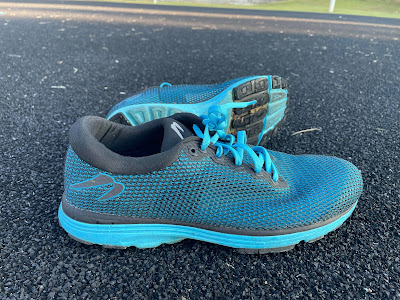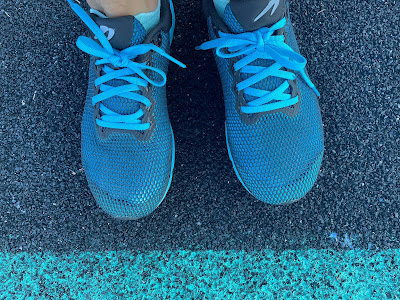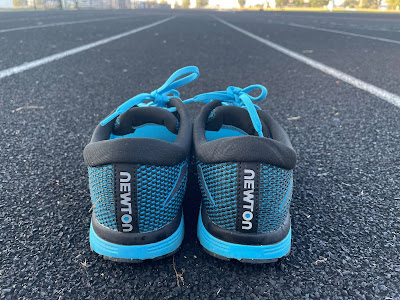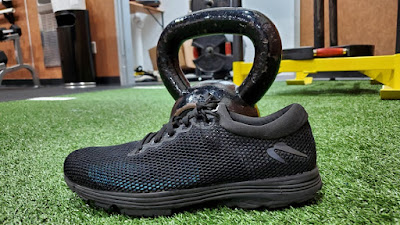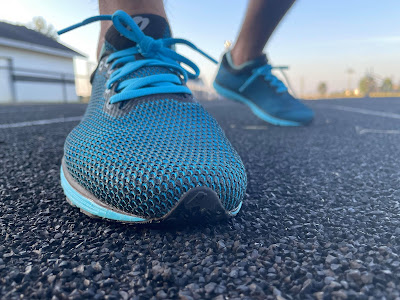Newton Catalyst Review
By Guest Contributor/DOR Social Media Manager Bach Pham and Contributor Ryan Flugaur
2021 has been an important year for Newton. The Boulder, Colorado-based company came into the year swinging with a total refresh, shifting their focus towards a sustainable future for the brand. Their models are now made entirely of recycled or biodegradable material called "EcoPure" which promises to help their shoes decompose in landfills 75% faster than the average shoe. Along with their new sustainable materials focus, they also launched new models including the Gravity+, their new workout and current distance racing shoe for the brand, and the Catalyst, a new lightweight workout/gym shoe that comes with the most breathable upper you'll find anywhere and a "XPS+" plated forefoot combined with their Action/Reaction technology.
Specifications for the Newton Catalyst (per Newton)
Weight: 7.4 oz (men's size 9) (women's size 8)
Stack Height: Unknown
Drop:6mm
Classification: Lightweight trainer/Gym
RUNNING SHOE SUMMARY
The Catalyst is a brand new offering from Newton and acts as a nice culmination of all the new changes they've introduced this year. The neutral running shoe features a unique open weave air mesh upper, their newly-introduced NRG midsole and an almost entirely sustainable construction which features EcoPure - material that promises to breakdown "75% faster" in landfills. The shoe also features a XPS+ plating system that sits towards the top of the midsole, working in tandem with their long-running Action/Reaction technology which uses lugs in the forefoot to help with a fast push off. On the run, the Catalyst is a fast, dynamic workout shoe thanks to its lightness and propulsive forefoot.
FIT
Bach: The Newton Catalyst fits very true to size. I had ample room in the toebox and nice space all-around. I know this because I see all of it through the very open weave air mesh upper. This is one of the most breathable shoes I have ever tried. You will definitely feel the air between your toes, which is a big reason I would recommend socks for a little added protection from the elements as you are whipping down the road. The shoe is very neutral, being easily flexed and folded in half. There is no heel counter in the Catalyst, and a very soft, padded heel collar which does a good job of securing the foot. Despite the minimal construction, I felt locked in and dialed even without doing a runner's knot.
It's worth noting that all of the elements of the upper and insole are made of recycled materialss. I found it to be a nicely cushioned shoe on step in between the HiLyte insole and surprisingly soft NRG foam which we'll talk more about in the performance section. There are two colorways for the Catalyst currently which keeps things simple between this somewhat arctic blue and a pure blackout version for those who like very minimally designed footwear.
Ryan: The Newton Catalyst fits great in my men’s
size 9. The tongue is lightly padded and very comfortable. I had no
issues with it moving as it sat firmly on the dorsum of my foot. The
mid and forefoot hug the foot providing a secure but not tight fit. The
upper is constructed of an open weave air mesh which lets your foot
breathe nicely when working out. When first putting on the shoe I was
surprised at how large the “holes” in the mesh are. This allows a
significant amount of open air to your foot. Living in Wisconsin, I
would be slightly worried when running outdoors in colder temperatures
as your feet would likely get cold. There is a very minimal heel
counter that offers a small amount of guidance to the foot as well as a
plush collar that adds to a secure fit. I found the fit to be
comfortable and secure and found myself reaching for the Catalyst when
just going out and about as it offers a comfortable ride that I could
wear for hours.
PERFORMANCE
Bach: For those who have never stepped in a Newton Running shoe, there's no doubt the first thing you'll really be taken aback by is the Action/Reaction lugs in the forefoot. They prominently lift you slightly off the ground, and just walking you'll think there's no way these can do anything good for you on the move. In fact, during your first runs if you are taking it easy, you may think these are the most useless things ever. For me when trying Newton (this is my third pair) I always put in a break-in period of several short shakeout runs as I ease into and get a feel for the shoe. Once you connect with what's going on, it makes a world of difference.
The one thing I found on my early runs was a bit of confusion on how to feel about the shoe. The NRG foam is actually fairly surprising. It's very soft and very comfortable on step in. In fact it may be one of the softest foams I've tried all year. The challenge I had early on though was the combination of the soft foam compressing and firmer lugs creating a harsh forefoot experience on roads. Easy runs on the road felt quite firm, making it a shorter distance shoe for me.
When I finally took it the Catalyst out for my first workout after a few short break-in runs, I really felt the shoe come alive. Being relatively light in the 7.4 oz range in tandem with the XPS+ forefoot plate - the plate is made from castor beans, continuing their sustainable focus - and lugs activating when speeding up, the shoe really flies quickly and does a nice job of turning over. The same problem came up again though: it felt good picking up speed and getting the benefits of the technology, but pounding the pavement made doing longer efforts difficult.
The Catalyst, however, found an absolutely perfect home on the softer track I had available in my neighborhood. Ripping a series of workouts on the track including a 5k time trial, the firmness I felt on road was perfectly balanced on the surface. I could really feel both the plate and lugs helping me to propel off the track during mid stance and toe off quickly. At the end of my 5k time trial I felt effortless as I pushed all out on the final 800 of my run. The minimalism of the shoe really lends itself to picking up the pace and letting your legs do the work while the Newton technology provides just a little bit of pop and assistance unique to the shoe. Between the minimal upper not weighing me down and the lugs helping provide a really nice push off, it really felt like it was replicating a track spike-esque experience, without the punishment of using a track spike.
One of the best comparative shoes to the Catalyst I have tried for 2021 is the Puma Liberate Nitro which has a similar minimalism to it. They both really put more emphasis on the runner to turn over and put the legs in motion. A key difference though is the combination of forefoot technology in the Catalyst which adds another dimension of propulsion to the run.
I don't know if I could recommend this as a daily trainer due to it's firmness on road, but if you are looking for a pure track shoe to blast workouts in without having to put spikes or a super shoe on, this is it. Additionally, I found the grip of the forefoot and shoe in general to be very nice on light trails and grass thanks to the softness of those surfaces. Anyone who has access to these types of surfaces and enjoys using a lighter shoe for training may be able to do some light daily training miles in the Catalyst as well. Additionally, I think you can get a lot of value here using it as purely a workout shoe you'll only be putting occasional miles in. I have some slight wear on the exposed foam putting it through the paces and on some gravel, but being a shoe I only pull out selectively for track work, I can get over the fact that it may be a lower durability shoe in the 200-300 mile range.
PERFORMANCE AS A GYM SHOE
Ryan: Due to my nagging calf injury, I have been unable to run in the Newton Catalyst, However, I was able to use them when going to the gym, running errands, and working 10 hour days at the clinic. Newton markets the Catalyst as a shoe with unstoppable versatility and I have to agree with them as I have used it for a variety of daily activities and found them to function well.
At the gym, I used the Catalyst for general workouts including weight lifting and HIIT (high intensity interval training). The Catalyst performs well as a general gym shoe but it shouldn’t be used to replace a true powerlifting shoe. Shoes designed specifically for powerlifting offer a raised heel to improve ankle range of motion and allow for a deeper squat. Power lifting shoes also have a very stable base under the foot to provide a platform when pushing into the ground. This typically means very little cushioning on the shoe. Newton uses a new lightweight NRG foam for the Catalyst that would likely be too soft for true powerlifting but is good for other gym activities including plyometric and general weightlifting workouts. Due to the minimal nature of the shoe, it requires a significant amount of foot and ankle control when performing plyometric workouts such as box jumps, burpees, and lateral jumps. This means that those individuals that require a bit of guidance may want to look elsewhere but for those that enjoy a more minimalist feel this is a great choice. For a runner that is looking to perform light resistance training the Catalyst will work well. If you are an individual looking to lift heavy and on a daily basis there are better options.
STABILITY | PROPRIOCEPTION THOUGHTS
Bach: The first time I tried the Newton Catalyst on, I said that there was no way I was going to get on with the shoe. The design of the midfoot curves in, making that part of the shoe feel very unstable. During my first walk in the shoe, I could feel my foot getting sore balancing on the thinner midfoot. I'm happy to say that it was completely irrelevant on the run though due to the Action/Reaction lugs. We've talked about proprioception - how your body senses the ground while moving - quite a bit on the site recently. As a flat footed runner, being able to clearly feel the ground through my shoe is one of the things I've found to greatly help with my sense of stability. It's often the reason I'm weary of shoes that have a narrow or even raised midfoot. Full ground contact outsoles in particular is one of the things I have found most important to opening up the array of shoes I can comfortably wear. Connecting with the ground is tremendously helpful it maintaining my balance on the move, and a full ground contact outsole is usually what really helps me confidently step and maintain balance through my gait cycle.
The unique thing about the Action/Reaction lugs on the Catalyst is that it shifts my proprioception needs entirely to the forefoot, giving me that ground contact feel I need to maintain my balance without having to use my midfoot through heel to maintain balance. The shoe really pushes you to want to spend the most amount of time in the forefoot and take off, leaving you spending far less time in the mid-to-heel. This was especially why I enjoyed it during workouts where I was spending a lot of time on my forefoot.
I mentioned the Liberate Nitro earlier and wanted to make some important comparisons to show why the Catalyst was a better shoe for me. Both offer a similar package: they are both very light, vert soft underfoot, and have a very flexible midfoot. The issue with the Liberate for me - despite having a full ground contact outsole - was that you really roll through the whole shoe, including the soft midfoot which often made me want to collapse and roll my ankle when going full blast. You really need a lot of strong foot strength and mechanics to take full advantage of the Liberate.
The Catalyst, however, retools that problem with the forefoot lugs which helped me connect with the ground and stabilize my foot strike, providing a stable, rigid component that I could connect with while taking off. It really took away from me thinking about the narrowly-constructed midfoot and ever worrying about collapsing or rolling my foot in anyway.
It's important to note that at the end of to the day this is still very much a neutral shoe. The lack of a rigid heel counter may also deter some folks who need a tight, stable heel. If you are a prominent heel striker, you'll still have a narrow midfoot to transition through even with the lugs helping offset it somewhat. The Action/Reaction system, however, does provides a fun workout option for people who only have the most mild stability needs.
Note: I personally am not a Doctor of Physical Therapy, and this is through much anecdotal experience of what has worked for me after trying a wide range of shoes at Doctors of Running.
RECOMMENDATIONS
Bach: Advertised as a road shoe and gym crossover, I felt the current forefoot comfort just doesn't feel great for daily use. Adding more cushioning throughout would really help make it more accessible for comfort on roads and help broaden it's usage. A more filled in mid to heel underfoot for full ground contact would also help with being a more stable platform for use in the gym. I really enjoyed the minimal construction and breathability of the shoe though and would love to see that maintained as there aren't many options like it in the market.
WHO THE NEWTON CATALYST IS FOR
Bach: The Newton Catalyst is best as a workout trainer on track. It can handle some easy running on softer surfaces like light trail or grass with the forefoot lugs providing just enough traction. The Action/Reaction technology along with XPS plate adds nice propulsion and some mild stability to the neutral shoe to help runners dig in and push some fast times in short to middle distance running. Within the Netwon line, this would be a great shoe to pair with their daily trainer model, the Newton Fate 7 to have that classic combination of trainer and workout shoe. In general, this would pair well with any daily trainer as a fast, efficient workout option if you prefer workouts on the track rather than road. You can also feel really good about Newton's use of sustainable construction from top to bottom at an ultimately pretty good price point compared to other sustainable shoes with the Catalyst coming in at $130.
GRADING
Bach
Fit: A- (Nice spacious forefoot, super breathable, no issues with fit in general)
Performance: C+/B+ (As a regular trainer, I couldn't recommend the shoe entirely as it feels so aggressively firm on the road, but as a workout trainer, especially on track, it should be on your list of non-super shoe/non-spike options)
Stability: B (Action/Reaction alone helps provide a very stable forefoot experience that lifts the shoe's stability somewhat, but still unstable for gym use)
DPT/Footwear Science: B+ (Really unique design between the XPS plate/Action Reaction forefoot and the upper design has to be commended for breathability)
Personal: B/B+ (Struggled early to find a place for it, but once I took it for workouts on track I wanted to grab it again and again)
Overall: B
SHOP | SUPPORT DOR
Find the Newton Catalyst currently only at newtonrunning.com
Check out Gear We Love (Affiliate links: Using the links below to shop helps supports Doctors of Running. Thanks so much!)
New Balance Rebel v2: One of the most fun trainers of 2021 so far
Asics Metaspeed Sky: Chief Editor Matt Klein can't stop racing in it, even on trails (not advised)
Hoka Arahi 5: One of the best stability shoes of the year, and the best walking shoe as well. Versatile.
Feetures Socks: Massively grippy socks that will make you feel more one with the shoe
Huma Chia Gel: Natural and goes down easy. Powered Contributor Nathan Brown to his marathon
Trigger Point Foam Roller: Help get those knots out post-run and feel better for tomorrow
Theragun Massager: This small version is great on the go for working tired legs
Ciele Hat: Our team's favorite running hat of choice!
FURTHER READING
Compare Lightweight Workout Trainers
Skechers Horizon Vanish 2 - 5.5oz in a sub $100 package
Puma Liberate Nitro - A very light sub-7 oz shoe that's fully flexible
Reebok Floatride Run Fast Pro - The lightest racing option in today's market. A rarity
Recently at Doctors of Running
ASICS Metaspeed Edge Review - A soft, but speedy 5-10k option
Carbon Plated Research: Which is Best Based on Running Economy? [Podcast]
New Balance FuelCell Prism v2 Review - The mild stability trainer gets some subtle refinements
Adidas SL20.2 Review - The workout shoe turned daily trainer is a solid do-it-all in the Adidas line for those looking for a simple, efficient trainer
Stable Neutral Shoes: What they are, Examples, Supination vs. Pronation
Thanks for reading!
Strava: Doctors of Running
Podcast: Virtual Roundtable
Pinterest: Doctors of Running
TESTER PROFILES:
Marketing and Social Media Manager
Bach Pham is a 140 lb male with PRs of 23 5K, 52 10K. He typically runs between 25-35 miles per week at a variety of paces between 7:30 (tempo) -10:00 (recovery) min/miles. He typically prefers shoes that provide some mild to firm cushioning underfoot that is lightweight and responsive. Currently his goals are to complete the half and marathon distances.
Editor's Note: As always, the views presented on this website belong to myself or the selected few who contribute to these posts. This website should not and does not serve as a replacement for seeking medical care. If you are currently injured or concerned about an injury, please see your local running physical therapist. If you are in the Los Angeles area, I am currently taking clients for running evaluations.
Contact us at doctorsofrunning@gmail.com
NEXT: ASICS Metaspeed Edge Review
